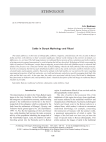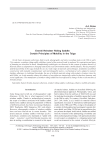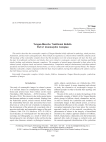Ethnology. Рубрика в журнале - Archaeology, Ethnology & Anthropology of Eurasia
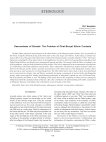
Descendants of eleudei: the problem of oirat-buryat ethnic contacts
Статья
Eleuths (Ölöts) played an important part in the ethnic history of the Mongol peoples of Inner Asia, in particular of the Oirats, being the dominant group of the Oirat union at the early stages of its history. In this study, an attempt was made to fi ll in one of the gaps in the ethnic history of the Turko-Mongol peoples, using the ethnonym “Ölöt”. The major limitation in studying the Oirat ethnic history is the insuffi ciency of sources. Much can be gained from using Buryat and Sakha (Yakut) folklore, specifi cally epics, genealogical legends, and tales. The reason is that the Ölöts, according to one of the hypotheses, took part in the formation of those peoples. This idea is supported by the reconstruction of protoforms of certain Buryat and Yakut ethnonyms and eponyms. Their comparative and historical analysis indicates ethnic ties between the Buryats and the Yakuts, and their participation in the ethnic history of the Mongolian stratum. These facts open up a wider perspective on Turko-Mongol ties. The Ölöt ethnic history shows them to have been distributed across vast territories of Inner Asia and Siberia, eventually becoming a component of various Turkic and Mongolian groups, while preserving their identity and featuring prominently in ethnogonic legends not only of Dörben-Oirats, but of the Buryats and Yakuts as well. The fi ndings of this study attest to the complexity of ethnic processes among the Mongolian and Turkic speaking nomads of Eurasia. Also, they contribute to the understanding of the ethnic composition of Mongolia, Buryatia, and Yakutia, thus widening the scope of studies on the Altai.
Бесплатно
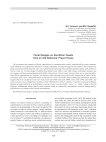
Floral designs on sacrificial towels from an old believers' Prayer house
Статья
We reconstruct the semantics of fl oral compositions on commemorative towels, embroidered by women, members of the Old Believers Bespopovtsy (priestless worship community rejecting marriage) in Novosibirsk. The original vine motif, associated with the funerary cult, was transformed by replacing vines with more familiar motifs, such as fl owers, berries, buds, etc. Certain designs resemble those found in late 19th to early 20th century embroidery manuals and on wrappers of cheap soap manufactured by Rallet, Brocard, etc. In most cases, however, there are no exact parallels. Some fl oral compositions are original: for instance, those showing vases with scrolls reminiscent of Jesus Christ’s monogram, and “vases” turned into letters on Our Savior’s icons. The results of the technological and stylistic analyses suggest that most sacrifi cial towels were made in the late 1800s and early 1900s, some in the 1940s and 1950s, and some may have been manufactured in places of the Old Believers’ former residence in northern and central Russia. Designs arranged in friezes or central fi gures, such as crosses, cruciate motifs, “vases”, or “vaults”, allude to the Old Believers’ fundamental values. Ritual towels evidence motifs on commercial embroideries creatively transformed by Old Believers according to their beliefs and traditions.
Бесплатно
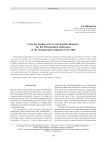
Статья
Serbian fi gured gingerbreads owned by the Russian Museum of Ethnography are described, the history of the collection is provided, and its cultural meaning is evaluated. Ethnographic parallels are analyzed, and archaic examples are cited. The custom of baking gingerbread results from the commercialization of the agricultural tradition of baking ritual bread. In terms of cultural anthropology, the question may be raised whether the replacement of destroyed originals by plaster replicas preserves the information potential and ethnographic value of the collection. Its interpretation is relevant to national identity in new Balkan nations such as Slovenia, Croatia, and Serbia. Another problem is if and how a craft shared by several peoples can be an ethnic marker. In terms of ethnographic museology in the globalizing world, the prospects of acquiring recent collections are discussed. The role of such collections in constructing new national identities may be considerable.
Бесплатно
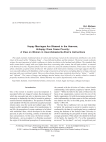
Статья научная
This study examines traditional ideas of women and marriage, based on the instructions attributed to one of the rulers of the epoch of the “Religious Kings”—Usun-Debeskertu-Khan, and his ministers. The focus is made on female virtues, the most important of which is adherence to duties in relation to the husband and children. The standards that noble women had to comply with were higher than those concerning other women, but still quite realistic, as attested to by historical records. Negative female traits were said to be caused by untamed emotions, which cause one to forget about commonly accepted norms of behavior. The analysis of the instructions relating to marriage suggests that they were especially influenced by Buddhism, which, using various forms of instruction, including didactic writings, endowed marriage with a new, spiritual content. There were three forms of marriage, tentatively described as “divine”, “earthly”, and “infernal”. The causes of happy and unhappy marital unions were believed to be mainly related to women’s properties mentioned in the instructions. Marital harmony was said to depend mostly on the woman.
Бесплатно
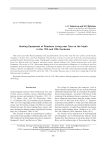
Hunting equipment of Russians living near Tara on the Irtysh in the 17th and 18th centuries
Статья
This article describes Russian hunting tools unearthed from several sites near the town of Tara on the Irtysh: Ananyino I, Izyuk I, Tara, and Fort Bergamak. The functions of tools are assessed on the basis of archaeological parallels from the Baraba forest-steppe, ethnographic examples relating to the culture of the Irtysh natives, materials from Fort Albazin and Fort Sayansk, and much earlier burials dating to the Xianbei-Rouran time in the Altai Mountains. The variety of 17th–18th century hunting tools is best represented at Mangazeya, Fort Alazeya, and Fort Stadukhin. Apart from typological comparisons, technological analysis was carried out for several wooden and metal artifacts. Results are helpful for revealing continuities between the 17th–18th century Russian hunting tradition at Tara and that practiced in Old Rus and in the 15th–17th century Russian state, as well as for comparing it with the Siberian native traditions.
Бесплатно
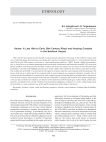
Kainar: a late 18th to early 20th century ritual and housing complex in the Northern Ustyurt
Статья
Бесплатно
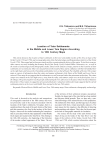
Location of Tatar settlements in the Middle and Lower Tara region according to 18th century maps
Статья
Тhis article discusses the location of Tatar settlements in the lower and middle reaches of the Tara on maps of the Tarsky Uyezd (1784 and 1798) and on topographic plan of the Kartashevskago and Bergamotskaya districts of the Tarsky Uyezd (1798). These maps had not been previously used for reconstructing the history of the region. To test their accuracy, other sources are used, including the Inventory Book of the Tarsky Uyezd, Gerhard Miller’s itineraries, etc., as well as the results of archaeological and ethnographic studies. Based on the analysis of maps, patterns in the locations of Tatar settlements are reconstructed. They were situated between the mouth of Tara and its confl uence with the Chertalinka River on the right bank, and between the Chertalinka and Kalinka rivers on the left bank. The reliability of the late 18th century maps as sources of information about the winter and summer settlements of the Tatars of the Middle and Lower Tara is assessed. These maps do not suggest that the settlements were still seasonal rather than permanent at that time. The winter camps were situated on the Tara high terrace, away from the valley, and summer camps were on the fl ood plain, close to the villages. The general pattern was that people settled along the river, often close to the places where the Tara tributaries fl owed into it. Place names are suggestive of seasonal settlements. Comparison with modern maps suggests that the current settlements pattern on the Lower and Middle Tara emerged in the late 18th century.
Бесплатно
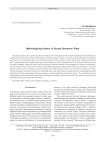
Mythologizing history in Buryat Shamanic rites
Статья научная
This study explores the regional specificity of Buryat rites with regard to the variable manifestation of mythological and historical components, and late innovations. The first attempt is made to reconstruct the mythological component of spoken texts accompanying these rites in the historical and ethno-cultural context. On the basis of field and archival data, contamination and transformation of myth and history in ritual is demonstrated. The principal characters such as deities, shamans, tribal and clan chiefs are described, and the semantics and pragmatics of ancestor and master- spirits in the historical context are discussed. The mythological status of supernatural characters of the rite is assessed. Specific ethnic criteria of turning real personalities into mythological characters in the historic context are listed. Universal features traceable in the process of turning history into myth include a regular mixture of mythological motifs with historical facts, interchange of temporal planes, and especially the reincarnation theme. The conclusion is made that pragmatic rites are the most stable, whereas the general tendency is that rites become less and less connected with mythology and progressively less hyperbolic.
Бесплатно
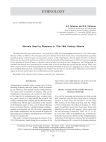
Shovels used by Russians in 17th-18th century Siberia
Статья
The study describes types of the shovel—one of the most widely used and multifunctional tools in 17th–18th century Russian culture of Siberia. The principal collection includes more than twenty intact and fragmented specimens unearthed during 13 fi eld seasons of excavations at Tara, in the Omsk Region. Shovels found elsewhere in Western Siberia are also described, and the role of this tool in the households of Russian pioneers in Siberia is assessed. Judging by the drawings in Semen Remezov’s chronicle and excavation records from Tara, Mangazeya, and Nadym forts, we conclude that shovels were specialized for various kinds of work, and that they varied with the season. There were diverse types used for constructing fortifi cations, dwellings and utility structures, for digging graves, tillage, clearing snow, handling bulk materials, and baking bread; children’s toy shovels are also described. Information is provided on shapes of shovels and the types of wood Siberians used for making them.
Бесплатно
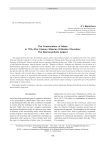
The consecration of altars in 17th–21st century Siberian orthodox churches: the neurosymbolic aspect
Статья обзорная
Бесплатно
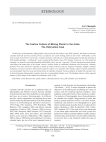
The festive culture of mining plants in the Urals: the Dobryanka case
Статья научная
On the basis of documentary ethnographic sources from the late 19th to early 20th centuries, the study reconstructs calendar festivals and rites of that period, recorded at one of the mining plants in the Urals—Dobryanka, in the western part of the Perm Governorate. Common festivals celebrated at Uralian mining plants include the greeting of birds (kashke-plishke), “sending off” water (seeing off the Kama), Day of St. Sergius, Pentecost, etc. The industrial calendar was related to the main household and holiday cycles; special “corporate” festivals emerged at private plants, coinciding with name-days of the plants’ owners; archaic forms of traditional ritualism were preserved; calendar festivals were more and more regarded as forms of leisure with less and less religious meaning; multiple calendar traditions coexisted; and new urban forms of festive culture were adopted. The holiday culture of plant settlements was intermediate between rural and urban forms of calendar ritualism. Each peculiarity of industrial calendar rites is described using ethnographic examples from the corresponding holiday cycle. The findings indicate rather unusual features of folk culture in the industrial settlements of the Urals.
Бесплатно
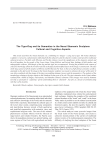
The tiger-dog and its semantics in the Nanai Shamanic sculpture: cultural and cognitive aspects
Статья научная
This article describes the Nanai shamanic set, combining two images—a dog and a tiger. The Nanai shamanic sculpture is viewed as a phenomenon reflecting both the subjective and the objective reality constructed by traditional cultural practices. Parallels with Siberian and Pacific cultures reveal the significance of the domestic animal and the wild predator for the people of the Lower Amur. Using folkloric and lexical data, findings of field studies, and ethnographic evidence, folk images of the dog and the tiger are reconstructed. Viewing the problem in the context of collective knowledge about the world reveals the archetypical and modified layers in the image’s construction. The idea of the dog, typical of all the peoples of Siberia and the Russian Far East, is that of a draft animal, assistant, sacrifice, and guide to the afterworld. Its image in the Nanai shamanic sculpture was meant to enhance the power of the spirit. It was often combined with the image of the tiger, personifying shaman’s power and the progenitors. The analysis of the terminology relating to the tiger attests to the Southeast Asian roots of its cult. The tiger semantics in the Nanai culture resulted from a blend of Tungus, Paleoasiatic, and Manchu (Chinese) elements. These images were used by shamans not only as assistants in “capturing” spirits and holding them in “detention”, but also as a means of communicating with the world of spirits.
Бесплатно
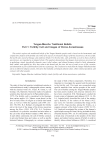
Tungus-Manchu traditional beliefs. Part 1: fertility cult and images of divine ancestresses
Статья
This article explores the traditional beliefs of the Tungus-Manchu peoples and is based on the hermeneutic and comparative analysis of the fertility cult. Some of its aspects are related to images of divine ancestresses, the tree of life, the hearth cult, ancestral lineage, and animistic beliefs. For the fi rst time, cults of fertility, as well as those of divine ancestresses, are regarded as an integral whole. This analysis demonstrates that images of ancestresses are preserved in mythology, rituals (specifi cally domestic ones), tribal culture, and cultural features related to birth, shamanism, ludic culture, and applied art. Also, they relate to the hearth cult, fi re rites, the tree of souls or tree of life, creation, and shamanism as part of folk medicine and rites of passage. The conclusion is made that the Tungus-Manchu fertility cult is an inherent religious system, relevant to the mentality, archetypal cultural values, ethno-cultural specifi city, and contacts with other peoples.
Бесплатно
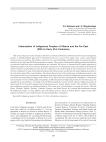
Urbanization of indigenous peoples of Siberia and the Far East (20th to early 21st centuries)
Статья
Бесплатно
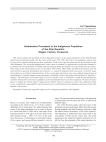
Статья
This article explores the specifi city of the urbanization process in the native population of the Altai Republic and assesses its principal trends over the course of the years 1926–2020. The focus is on quantitative aspects such as the growth of urban settlements and their population. I look at the ways the urban network has developed in the Altai Mountains. The only urban administrative center shows a potential for agglomerative growth and continues to accumulate the rural population. Townships that had emerged during the Soviet period were unattractive for natives. Three stages in the urbanization process are described: 1926–1950s, 1960–1980s, and 1990 to the present. Over the entire period in question, urbanization was extensive, i.e. caused by migration from rural areas. At the fi rst stage, the key factor was political (collectivization). In the second stage, the factors were socio-cultural (attractiveness of urban lifestyle), economic (higher income and greater availability of jobs), and political (the abolition of “futureless” villages). The main factor at the third stage was socio-economic crisis. A conclusion is made that the potential for extensive urbanization in the native population of the Altai Republic has not yet been exhausted. The most attractive places to migrate are still the region’s capital and its suburbs. However, migration to other cities of Russia is likely to rise. A prediction is made that the role of intensive factors of urbanization in the indigenous population of the Altai Republic will increase.
Бесплатно

